Sauce Chimichurri: From Asado Tradition to Global Kitchens
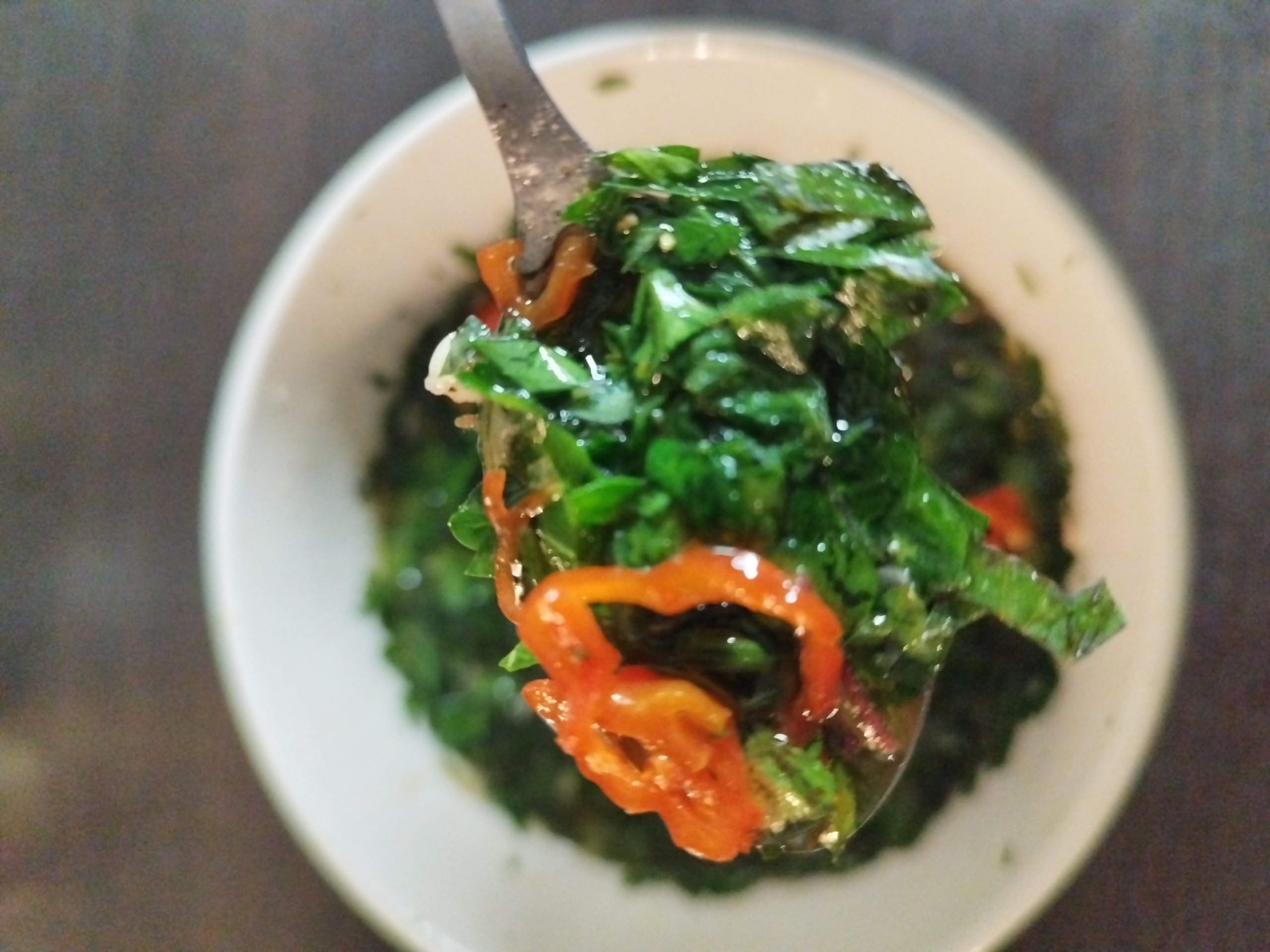
Introduction
Chimichurri is an uncooked, rich, and fresh sauce coming from South America (Argentina and Uruguay, but also Paraguay, Chile, Brazil, Peru), made with chopped green herbs like parsley and oregano, together with aromatics like garlic and chili peppers, in combination with olive oil and vinegar.
The sauce is closely related to those countries’ culinary tradition of asado—a technique of cooking meat over open fire/charcoal. Chimichurri is typically served alongside grilled meats, sausages, empanadas, etc. Like many other sauces, Chimichurri sauce has evolved beyond its origins in South America, becoming a well-known global sauce.
It is interesting that there is no single official recipe for chimichurri, as each cook or family has its own ingredients, proportions, and versions (less or more of one herb or spice, different vinegars, etc.).
Chimichurri can be seen in two varieties: Chimichurri verde (green) and Chimichurri rojo (red). Chimichurri verde’s main ingredients are fresh chopped parsley and fresh oregano, together with garlic, oil, and vinegar, while Chimichurri rojo uses sweet and smoked paprika, roasted red bell pepper, and chilies.
Culinary Usage of Chimichurri Sauce
- As a Sauce: Used as finishing touch to a well-prepared grilled (churrascos) or roasted meats, fish, or vegetables for brightness and acidity.
- As a Marinade: Perfect for beef, chicken, lamb, etc. The vinegar tenderizes the meat while the herbs infuse the meat with aromatic flavor.
- In Dressings: Can be added into dressings for salads.
- As a Condiment for Sandwiches and Tacos: Can be used instead of mayonnaise and ketchup.
- As a Table Sauce: It is so versatile that you can serve it on any rich meal, like salsa or pesto.
Alternative Ingredients for Chimichurri
Experimentation & Variations
Chimichurri, although traditional, has endless possibilities and combinations. While I prefer to stick to the original recipe using fresh herbs, you can experiment with dried herbs, vinegars, and oils as much as the sugar and acid that can be used in gastrique sauces.
Herb and Aromatics Options
Classical recipe: parsley, oregano, garlic
Variations of the recipe: cilantro, basil, mint, sage, or thyme
Acid Options
Classic recipe: red wine vinegar
Alternatives to red wine vinegar: sherry vinegar, apple cider vinegar, or lemon/lime juice
Oil Options
Classic: olive oil
Alternatives: avocado oil or sunflower oil
Heat & Spice
Classic: fresh red chilies
Instead of fresh red chilies, one can use red chili flakes, fresh jalapeño, or smoked paprika for depth
Preparation of Chimichurri Verde
The only secret to a great Chimichurri is in the ingredients. Fresh parsley, fresh oregano, and garlic will create the aromatic base capable of elevating any grilled meat or vegetable, while the red wine vinegar and oil will balance each other and contribute to the richness and freshness of the sauce.
For This Recipe, You Will Need
- Fresh Parsley: Ideally use flat-leaf parsley over curly parsley, as it is more flavourful and colourful.
- Garlic: I recommend using fresh garlic bulbs instead of powdered or pre-minced. It will give you this subtle kick of flavor and pungency. When you choose your garlic, aim for bulbs that have no signs of sprouting or spoilage.
- Oregano: I recommend using fresh oregano, but dried oregano can also work well in chimichurri. If you choose to use fresh, select one so that the leaves and stem are green and the bunch has a nice aroma. If you don’t have fresh oregano at hand, use dried with robust aroma and colour.
- Olive Oil: Use cold-pressed extra virgin olive oil for superior taste and health benefits. The olive oil will be the carrier of flavors from the aromatics used (herbs, garlic, and chilis), so strive for the best quality.
- Red Wine Vinegar: The red wine vinegar should be made from 100% red wine. Aim for one that says it is made from grapes and has undergone acetic acid fermentation. Try to avoid buying vinegar that doesn’t say it is made from a particular sort of grapes, and if not it will generally be made from low-grade wines or blends. As a substitution, you can use white wine vinegar or lemon juice.
- Fresh Chilies: Depending on the heat level you prefer, you can choose either mild varieties for balance, like ají molido or Fresno, or medium to hot varieties for pungency, like Thai chilies or cayenne peppers. If you don’t have access to fresh chilies, you can substitute them with chili flakes.
NB: Please don’t use a blender for chimichurri!
Step-By-Step
- Gather your ingredients.
- Finely chop parsley, oregano, garlic, and red chili. This will be your flavour base for the sauce.
- Mix the chopped ingredients together in a bowl with olive oil and red wine vinegar. Stir well to incorporate all the ingredients for the sauce.
- Prepare it at least a few minutes before you are going to use it. This will ensure that the flavors combine well.
- Use the sauce as needed.

Versions
Chimichurri Verde: fresh parsley, fresh oregano, garlic, chilies, oil, and red wine vinegar
Chimichurri Rojo: fresh parsley, fresh oregano, garlic, chilies, roasted red bell peppers, red paprika, smoked paprika, oil, and red wine vinegar
Storing and Shelf Life of Chimichurri Sauce
Chimichurri can be stored in an airtight, non-reactive (metal is not a good option) container in the refrigerator for 5–7 days. If you minimize air exposure—cover all the ingredients in oil—it can last for up to two weeks (14 days). I don’t recommend freezing it; it’s quicker to make it from scratch than to thaw one.
The Science of Chimichurri
Now, when you have made and hopefully enjoyed the sauce, let’s look closely at the science behind its beautiful flavour. The main secret lies in the balance between the flavour of the herbs, the acidity, and the oil. The acid, herbs, and chiles cut through the fattiness of the meat, garlic adds aroma and depth, while the olive oil decreases the sharpness of the vinegar—an ideal part of a classical pairing with rich meats such as beef and lamb.
First, at its core, chimichurri is a type of vinaigrette: an emulsion of oil + acid (with added aromatics).
Oil
It acts as a solvent for the aroma compounds found in the ingredients used (1). Those include apiol in parsley, thymol in oregano, allicin in garlic, and capsaicin in chilies. Some of them are hydrophobic (lipophilic), meaning they will dissolve readily in oil, changing the mouthfeel and the release of aroma while eating.
Acid (pH Regulator and Water Phase)
Acidity from the red wine vinegar will add freshness and equilibrium, balancing the richness of the oil. It activates taste receptors, which will reflexively increase salivation (2). The saliva can help dissolve substances found in the aromatic and spice component of the sauce and spread them across the mouth. A glycoprotein in the saliva called mucin also helps with the stabilization of emulsions, since it’s a biological surfactant—thus delivering more of those flavour molecules to the receptors in the mouth.
Aromatics
They provide volatile molecules like allicin (garlic), terpenes (herbs), and capsaicin (chili), which stimulate different receptors in the olfactory and trigeminal systems, creating a complex sensory experience (3,4).
Ingredients
Method
- Gather your ingredients.
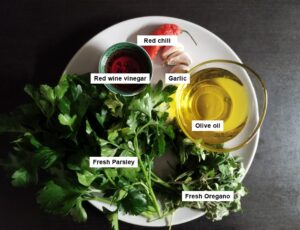
- Optional: Remove the stems from the parsley and the oregano.
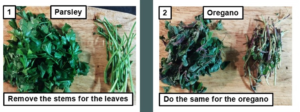
- Finely chop parsley, oregano, garlic, and red chili.
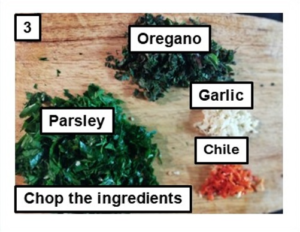
- Mix the chopped ingredients together in a bowl with olive oil and red wine vinegar.

- Stir well to incorporate all the ingredients for the sauce. Prepare it at least a few minutes before you are going to use it. This will ensure that the flavors combine well.
- Use the sauce as needed.
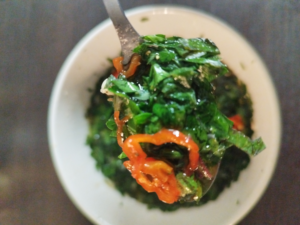
References
Gautam, A. K., & co-authors. “Preparation and characterization of fragrance by extracting the essential oils from different raw materials.” Journal of the Indian Chemical Society. https://doi.org/10.1016/j.jics.2021.100178
Satoh-Kuriwada, S., Shoji, N., Miyake, H., Watanabe, C., & Sasano, T. “Effects and Mechanisms of Tastants on the Gustatory-Salivary Reflex in Human Minor Salivary Glands.” BioMed Research International. https://doi.org/10.1155/2018/3847075
Frasnelli, J., Schuster, B., & Hummel, T. “Interactions between olfaction and the trigeminal system: what can be learned from olfactory loss.” Cerebral Cortex. https://doi.org/10.1093/cercor/bhl135
Viana, F. “Chemosensory Properties of the Trigeminal System.” ACS Chemical Neuroscience. https://doi.org/10.1021/cn100102c
